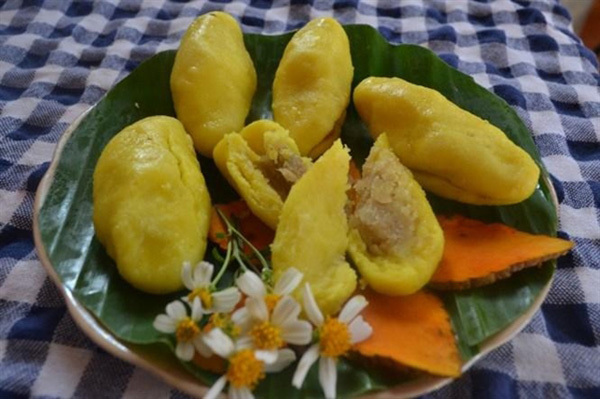It’s one of many popular cakes from the province. Others include bánh cáy (cáy cake), bánh nếp (sticky rice), bánh chưng (square cake), or bánh mật (molasses-sweetened glutinous rice cake) but not quite the same local baker, Tran Thi Dao says.
“It’s different from other cakes… people can eat a lot and they don’t need to be afraid to eat too much,” she says.
Tien Hai District’s, Nam Trung Village is considered the birthplace of bánh nghệ. Many local villagers make a living preparing and selling these cakes to people of all ages.
 |
| Bánh nghệ (turmeric cake), a popular traditional cake that has been eaten for hundreds of years in Thai Binh Province. Photo toplist.vn |
“This rural popular cake is enjoyed by not only adults but also children because of its soft, fragrant rice and turmeric. It is also very nutritious,” she said.
Dao says that to make the tastiest cakes the right ingredients are very important. Thai Binh rice must be used and makes a dough that is not too wet and not too dried.
Many bakers have taken to using dried turmeric powder, however, Dao says the cake is more delicious and fragrant when the turmeric is fresh. She uses turmeric and onion straight from her garden.
 |
| Dumplings are put in the middle of turmeric dough. They are balled before being steamed. Photo nghienbep.com |
To make the cake the rice is soaked in water for 4-5 hours and then ground into a half wet and half dry dough. Turmeric is ground down and its essence is filtered into a turmeric juice. The turmeric is added to the dough and the mix is steamed.
For the filling Dao adds diced onions, minced pork scraps, a touch of cinnamon powder and fish sauce and fries it up in a skillet.
Then it’s a matter of bringing the dough and the filling together.
Dao says the dough should be divided into small balls about the size of a chicken egg. The filling is pushed into the centre of the ball. They are then steamed on the fresh banana leaves for 30 minutes.
“The cake is tastier when enjoyed hot,” she says.
Making a living selling bánh nghệ however, takes hard work.
“We have to wake up very early in the morning to make the cake so that we can bring it to the market at 5am,” Dao says.
But Dao says she enjoys it.
“I’m glad and happy because my customers are increasing and I have many repeat customers who enjoy my cakes.”
“During special occasions like Tet, I often receive a lot of orders from diners in Hai Phong, HCM City and other southern provinces. Sometimes my relatives in the US also ask me to send them cakes too,” she says.
 |
| Fresh turmeric is one of the main ingredients in the cake. Photo cnthucpham.donga.edu.vn |
Nguyen Van Bieu, who was born in Thai Binh’s Nam Trung Village, now works in Hanoi, and says that he often takes his children back to the village’s Quan Market to enjoy bánh nghệ.
“It is a very good chance for me to share the story of the cake that is so closely connected to my childhood and now to my children,” he says.
“I told them that I was very happy [as a child] because every morning before going to school my mother would often give me one or two bánh nghệ. For me, it was an excellent breakfast that I can never forget,” Bieu says.
He said bánh nghệ is very good for the digestive system and physical development because the cake does not have any preservatives or colouring products.
 |
| Locals are happy to enjoy the cakes. Photo thaibinhtv.vn |
Village herbalist Bui Van The said turmeric is considered a good traditional anti-inflammatory medicine that has detoxifying properties and increases resistance to disease.
“The turmeric may also give women good skin and prevent postnatal problems for pregnant women,” The said. She went on to recommend bánh nghệ as a good gift for pregnant women.
Travellers to the province that want to try the tastiest and nutritious turmeric cake should visit local markets in Nam Trung and Nam Thanh villages, The advises.
Source: Vietnam News

Story of cay cake in Thai Binh
Thai Binh is commonly known for its immense rolling fields, but a tastier treat it is home to is the bánh cáy, or cáy cakes, made of sticky rice, sugar, gấc (gardenia fruit), sesame seeds, carrots, mandarin peel and lard.

'Cay' cake - A specialty of Thai Binh
Each locality in Vietnam has its own specialty that it is proud of. Visitors to Nguyen Xa village, in Thai Binh province are always invited to eat ‘cay’ cake, which is made of glutinous rice well blended with fat and ginger.